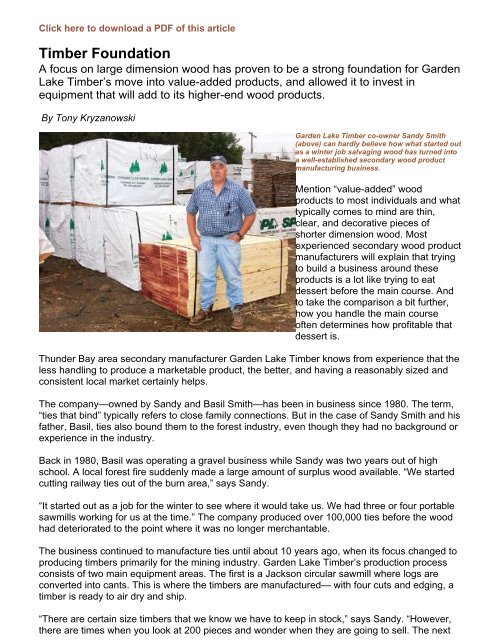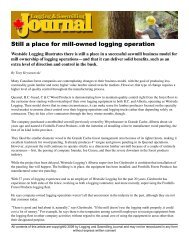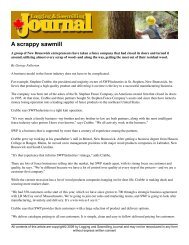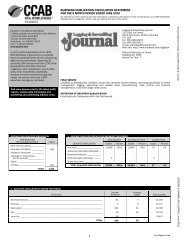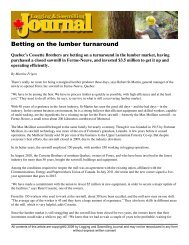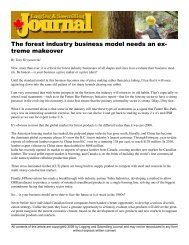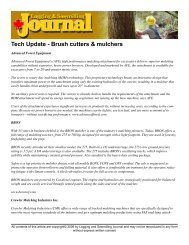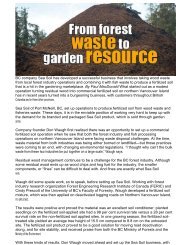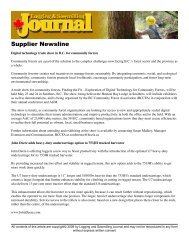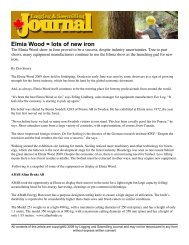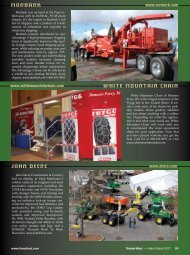Click here to download a PDF of this article - ForestNet
Click here to download a PDF of this article - ForestNet
Click here to download a PDF of this article - ForestNet
You also want an ePaper? Increase the reach of your titles
YUMPU automatically turns print PDFs into web optimized ePapers that Google loves.
<strong>Click</strong> <strong>here</strong> <strong>to</strong> <strong>download</strong> a <strong>PDF</strong> <strong>of</strong> <strong>this</strong> <strong>article</strong><br />
Timber Foundation<br />
A focus on large dimension wood has proven <strong>to</strong> be a strong foundation for Garden<br />
Lake Timber’s move in<strong>to</strong> value-added products, and allowed it <strong>to</strong> invest in<br />
equipment that will add <strong>to</strong> its higher-end wood products.<br />
By Tony Kryzanowski<br />
Garden Lake Timber co-owner Sandy Smith<br />
(above) can hardly believe how what started out<br />
as a winter job salvaging wood has turned in<strong>to</strong><br />
a well-established secondary wood product<br />
manufacturing business.<br />
Mention “value-added” wood<br />
products <strong>to</strong> most individuals and what<br />
typically comes <strong>to</strong> mind are thin,<br />
clear, and decorative pieces <strong>of</strong><br />
shorter dimension wood. Most<br />
experienced secondary wood product<br />
manufacturers will explain that trying<br />
<strong>to</strong> build a business around these<br />
products is a lot like trying <strong>to</strong> eat<br />
dessert before the main course. And<br />
<strong>to</strong> take the comparison a bit further,<br />
how you handle the main course<br />
<strong>of</strong>ten determines how pr<strong>of</strong>itable that<br />
dessert is.<br />
Thunder Bay area secondary manufacturer Garden Lake Timber knows from experience that the<br />
less handling <strong>to</strong> produce a marketable product, the better, and having a reasonably sized and<br />
consistent local market certainly helps.<br />
The company—owned by Sandy and Basil Smith—has been in business since 1980. The term,<br />
“ties that bind” typically refers <strong>to</strong> close family connections. But in the case <strong>of</strong> Sandy Smith and his<br />
father, Basil, ties also bound them <strong>to</strong> the forest industry, even though they had no background or<br />
experience in the industry.<br />
Back in 1980, Basil was operating a gravel business while Sandy was two years out <strong>of</strong> high<br />
school. A local forest fire suddenly made a large amount <strong>of</strong> surplus wood available. “We started<br />
cutting railway ties out <strong>of</strong> the burn area,” says Sandy.<br />
“It started out as a job for the winter <strong>to</strong> see w<strong>here</strong> it would take us. We had three or four portable<br />
sawmills working for us at the time.” The company produced over 100,000 ties before the wood<br />
had deteriorated <strong>to</strong> the point w<strong>here</strong> it was no longer merchantable.<br />
The business continued <strong>to</strong> manufacture ties until about 10 years ago, when its focus changed <strong>to</strong><br />
producing timbers primarily for the mining industry. Garden Lake Timber’s production process<br />
consists <strong>of</strong> two main equipment areas. The first is a Jackson circular sawmill w<strong>here</strong> logs are<br />
converted in<strong>to</strong> cants. This is w<strong>here</strong> the timbers are manufactured— with four cuts and edging, a<br />
timber is ready <strong>to</strong> air dry and ship.<br />
“T<strong>here</strong> are certain size timbers that we know we have <strong>to</strong> keep in s<strong>to</strong>ck,” says Sandy. “However,<br />
t<strong>here</strong> are times when you look at 200 pieces and wonder when they are going <strong>to</strong> sell. The next
thing you know, you are behind 200 pieces.”<br />
the other material is basically byproduct.”<br />
Garden Lake Timber co-owners Basil (left)<br />
and Sandy Smith have replaced an old planer<br />
with a new Leadermac planer, which will give<br />
their secondary wood products a finer finish.<br />
Sandy also knows that occasionally<br />
he will receive a request for a<br />
specialty item like a 12x12 timber.<br />
To accommodate that cus<strong>to</strong>mer, he<br />
will keep his eyes open for a log big<br />
enough <strong>to</strong> fill the order and will s<strong>to</strong>re<br />
the log itself in inven<strong>to</strong>ry<br />
until—predictably— an order arrives.<br />
“We’re sawing timbers mainly <strong>to</strong> get<br />
as much board feet out <strong>of</strong> a log as<br />
we can,” says Sandy. “If you are<br />
sawing an 8x8, you are not making<br />
very many units and you are still<br />
retaining the board feet in the log. All<br />
Unlike large volume sawmills, he says his sawmill needs <strong>to</strong> produce 6x6s, 8x8s and 10x10s <strong>to</strong><br />
achieve any reasonable amount <strong>of</strong> production per day. They leave the 2x4s and 2x6s <strong>to</strong> others,<br />
which in the end works <strong>to</strong> their advantage. “We are not interfering in someone else’s market by<br />
focusing on timber,” says Sandy. “That’s why they don’t mind us being <strong>here</strong>.”<br />
In fact, Garden Lake Timber acquires a portion <strong>of</strong> its wood supply from other forestry operations.<br />
Typically, these are oversized logs that dimension sawmills can not break down economically or<br />
wood species that they’d like <strong>to</strong> avoid such as birch, cedar, tamarack and black ash. Sandy says<br />
a phone call from a wood supplier is how Garden Lake broke in<strong>to</strong> the birch lumber market. They<br />
started <strong>to</strong> develop a market sawing hardwood rail ties, grade lumber and hardwood cants. The<br />
ties and cants were exported <strong>to</strong> the US.<br />
In the event that a cant is destined for further value adding, or “expense adding” depending on<br />
your point <strong>of</strong> view, the company rips the cants on a Brewco two-headed band resaw that it<br />
purchased some time ago and has rebuilt at least once. They have built their own dry kiln and<br />
some <strong>of</strong> the wood will also air dry. At present, the dried lumber is moulded on a Pres<strong>to</strong>n planer,<br />
but Garden Lake Timber has made a major investment in<strong>to</strong> a Leadermac six-headed moulder.<br />
Leadermac is a Taiwanese-based company that has been in business since 1972. It moved in<strong>to</strong><br />
a new fac<strong>to</strong>ry in 2005 and has a significant presence, particularly in Europe. In Canada and the<br />
Western United States, the company is represented by Akhurst Machinery Limited.<br />
This ranks as one <strong>of</strong> Garden Lake Timber’s most significant purchases in new equipment, and<br />
they believe it will take the quality <strong>of</strong> their product <strong>to</strong> a new level.<br />
“It will allow us <strong>to</strong> do a lot <strong>of</strong> things,” says Basil Smith. “The planer we are using now does a<br />
decent job but it runs at 3,500 rpm. The Leadermac runs at 8,000 rpm, so we will get a much<br />
finer finish on our paneling and flooring.”<br />
In effect, the company’s strong focus on timbers over the years is helping it invest in equipment<br />
that will allow it <strong>to</strong> improve on its higher-end wood products.<br />
For example, the company manufactures decking as well as <strong>to</strong>ngue and groove paneling from<br />
cedar in dimensions from 2x4 <strong>to</strong> 2x8. They visually grade the wood, pull any clears, and can
produce wood products as small as 1x2, which can be sold as trim or moulding. The company<br />
also produces lath, grade stakes, strapping material and some special sized pallets.<br />
Having an efficient new planer <strong>to</strong> create a finer finish is particularly important when attempting <strong>to</strong><br />
capture maximum value from wood species like black ash. It is used for flooring, wall paneling<br />
and trailer decks.<br />
“The only thing worth anything from black ash is the high grade,” says Sandy. “You can hardly<br />
plane the material with knots because it is so hard. If it’s a clear, it makes a nice product.<br />
Anything less than that and the value drops <strong>of</strong>f in a hurry.”<br />
Garden Lake Timber has tried <strong>to</strong> produce patio decking from tamarack, but they have had<br />
problems with twists, cracks and raised grain that can lead <strong>to</strong> slivers.<br />
Since Garden Lake Timber produces wood products that don’t compete with larger<br />
sawmills, those sawmills are quite willing <strong>to</strong> sell the company lesser used species<br />
and oversized wood, <strong>to</strong> convert in<strong>to</strong> marketable solid wood products.<br />
They’ve found it is more suitable as an industrial wood for use as<br />
low bed trailer decks because it is so heavy and <strong>to</strong>ugh. They’ve<br />
also discovered that it is easier <strong>to</strong> saw when it is frozen.<br />
Although spruce and pine are what the company principally uses<br />
<strong>to</strong>day, that has not always been the case. “Three years ago, we<br />
were sawing 100 per cent hardwoods,” says Sandy. “Before that, it<br />
was pine and cedar. Whatever seems <strong>to</strong> make sense at the time is<br />
w<strong>here</strong> we go.”<br />
Because the company has been in business for over 25 years, it<br />
has established a fairly solid cus<strong>to</strong>mer base, but that does not<br />
necessarily mean that they are entirely certain w<strong>here</strong> the business<br />
will come from.<br />
Sandy says they try <strong>to</strong> stay at least a week ahead on production, “but a lot <strong>of</strong> our cus<strong>to</strong>mers base<br />
their needs on justin- time delivery.” One <strong>of</strong> the benefits <strong>of</strong> experience is they have developed an<br />
understanding <strong>of</strong> the most popular items and maintain a small inven<strong>to</strong>ry in the yard.<br />
part <strong>of</strong> what keeps us going.”<br />
The Jackson sawmill is the starting point and backbone <strong>of</strong> the secondary<br />
manufacturing process at Garden Lake Timber.<br />
The Garden Lake Timber business model is similar <strong>to</strong> secondary<br />
manufacturers who supply lumber <strong>to</strong> the oil and gas sec<strong>to</strong>r for<br />
use in their exploration or extraction activities. Other resource<br />
industries have a need for it because wood is <strong>of</strong>ten readily<br />
available, is a cheaper building material, and easy <strong>to</strong> handle and<br />
versatile.<br />
T<strong>here</strong> are two operating mines within 300 kilometres <strong>of</strong> Garden<br />
Lake Timber and several more within an accessible distance.<br />
Exploration for precious metals is booming all over Canada at<br />
the moment. “They are drilling, developing, and exploring all<br />
over the place right now,” says Sandy. “The mining industry is<br />
In addition <strong>to</strong> timbers, the company also manufactures a specialty product for the mining<br />
industry: core trays. They are a wood tray and s<strong>to</strong>rage system w<strong>here</strong> the drilling company places<br />
the core samples it gathers for assaying. T<strong>here</strong> are many different sizes and shapes <strong>of</strong> core<br />
trays.
Garden Lake Timber, with its various products, has become a major supplier <strong>to</strong> the mining and<br />
exploration sec<strong>to</strong>r. And the growth and evolution <strong>of</strong> the business has surprised even the Smiths,<br />
considering it was originally intended as a short-term winter job. Yet Sandy and Basil say the<br />
journey has been quite satisfying


